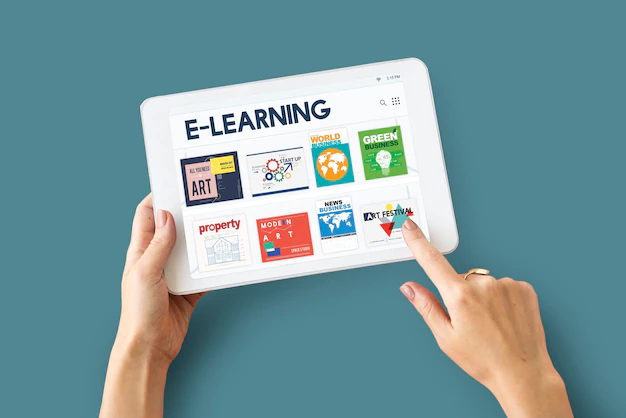Designing an Effective Blended Learning Program in 5 Steps

What exactly is blended learning?
Blended learning program are a type of training that combines online resources and opportunities with traditional classroom-based teaching methods.
While the learners attend classroom sessions with their peers and instructor, these face-to-face practices are enriched with online activity for content and delivery.
Blended learning provides the best of both worlds: on the one hand, you benefit from synchronous learning strategies while also reaping the benefits of asynchronous learning and learning at your own pace and convenience.
Many organizations are now using digital resources to supplement their learning and development strategy without foregoing the advantages of instructor-led classroom interactions.
How do you create effective blended learning courses that are engaging, interactive, immersive, and flexible?
In this blog post, we will go over how to create an effective blended learning program.
Example Of A Blended Learning Plan
A blended learning strategy could begin with Instructor-Led Learning, which allows students to meet the instructor and each other in one physical location.
There may be a Virtual Reality activity done in smaller groups during that seminar. The students can then be assigned eLearning homework hosted on an LMS platform, and their answers can be reviewed in a discussion forum or via a hosted video.
With a blended learning program, you can capitalize on the strengths of each type of training, such as the powerful social learning inherent in ILT, the self-paced control provided to learners in eLearning, and the unparalleled engagement provided by immersive learning.
Such a comprehensive approach contributes to the knowledge retention and behavior change that your company seeks.
ALSO READ: A Comprehensive Guide on Blended Model
What are the advantages of blended learning for educators and organizations?
Lowering costs is one of the most significant advantages of blended learning programs for faculty and organizations. Blended learning also increases engagement and makes it easier to keep track of your students and employees.
Save money
Blended learning saves businesses money that would otherwise be spent on printing, travel, and lodging. Because the majority of the work is done online, you can save money on facility costs.
Furthermore, individuals can save money on gas and travel expenses, such as public transportation, that they would normally use to get to class.
Create engagement
Another advantage is a demonstrable increase in student or learner engagement. It translates to better employees for a company and more knowledgeable students. This reflects well on the employer or instructor and can give you confidence that you’re assisting students in the best way possible.
Keep students on track
The web component of hybrid learning makes it simple to keep track of your students and employees.
TechSmith Knowmia Pro includes video analytics tools that can be used to track video statistics.
The results are automatically collected, providing you with a concise and accurate view of who has and has not completed the lesson or training. You can also see what areas specific students/employees need to work on.
Steps to design Blended Learning Courses
1. Define the Outcomes of the Course
The first step, as with any learning strategy, is to define the objectives and goals you want to achieve with your blended learning strategy.
The following questions can help you define your goals:
- What skills do you want to instill in your students?
- What information should the blended learning course contain?
- To deliver new knowledge and information, what instructional design models and instructional tools should be used?
Your goals and objectives will serve as a guideline for creating blended learning courses. At each step, you’ll be able to see where your path is taking you and what you need to change or cover along the way.
2. Create an Outline for the Blended Learning Course
A course outline is advantageous to all participants. The outline can help learners stay on track, and the instructor/course developer can use it to ensure that the blended learning course progresses at the desired rate.
In your course outline, include the course objectives, assignments, papers, and tests that must be completed, as well as the deadlines that students must meet.
Also, make it clear what you expect from the students in terms of attendance and participation. Finally, specify which instructional tools and materials will be used to deliver blended learning content.
3. Determine the Level of Interactivity
One significant advantage of blended learning is that it gives learners more control over their learning. Learning is not solely based on the information imparted by the instructor, but also on the use of both online and offline resources. Learners can instead progress through self-paced learning activities.
Determine the level of interactivity of your course when designing your blended learning content. How much learning will take place in the classroom and how much will take place via live online media?
How much of it will be self-education via interactive activity?
When you choose blended learning, you gain access to a diverse set of online learning resources and delivery methods.
For example, your students can gather in a classroom or other common area, and an instructor from another city or country can deliver a lecture via an online environment.
In fact, there are numerous options, and you will need to spend some time selecting one that is best suited to your blended course requirements.
The best course of action is to assess your modules and then determine which activities can be used to effectively communicate the core ideas.
4. Integrate Group Collaboration Activities
While learning at your own pace has its advantages, group collaboration is essential. Team learning allows learners to interact with their peers, share knowledge, and benefit from each other’s skill sets.
There are numerous online tools and applications available to promote group activity.
For example, your group could enter a chat room to discuss a specific issue. They can use social media to express their ideas, opinions, and thoughts.
In addition to designing an effective blended learning course, you should also develop an effective social learning strategy to take learning outside of the classroom and open conversations to a larger audience.
These group interactions will also help your students develop problem-solving, analyzing, and rational thinking skills.
5. Evaluate Results and Program Effectiveness
After your program has been running for a while, it is time to assess its effectiveness and results.
What to look for:
- What is the success rate?
- Are the learning objectives being retained?
- Are they using what they learned?
Find those critical key performance indicators and use them to assess your program’s success. Don’t be afraid to make changes; they may be required to keep up with evolving processes, policies, or students’ learning styles.
Conclusion
Blended learning programs provide numerous benefits and will be widely adopted by businesses in the coming years.
Blended learning programs can be used effectively by organizations and businesses as part of their learner-centric corporate training strategy.





